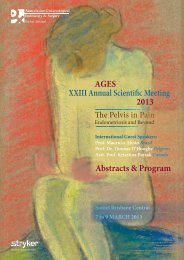to Obstetric Trauma Pelvic Floor Repair Surgical Essentials - AGES
to Obstetric Trauma Pelvic Floor Repair Surgical Essentials - AGES
to Obstetric Trauma Pelvic Floor Repair Surgical Essentials - AGES
Create successful ePaper yourself
Turn your PDF publications into a flip-book with our unique Google optimized e-Paper software.
Free<br />
Communications<br />
Session 7B<br />
Saturday<br />
4 June<br />
separate mesh straps are only connected at in the presacral space<br />
at the level of the sacral promon<strong>to</strong>ry <strong>to</strong> leave the intact vault or<br />
post hysterec<strong>to</strong>my vault suture line free of mesh <strong>to</strong> decrease the<br />
incidence of mesh exposure which appears <strong>to</strong> have been very<br />
successful. We have recently refined the procedure even further <strong>to</strong><br />
repair the anterior or posterior compartment in isolation as well as<br />
the vault by performing a ‘Anterior Sacrocolpexy’<br />
We present a video of TLH with uterosacral suspension and anterior<br />
and middle compartment Mesh sacrocolpopexy using the V loc<br />
suture for anterior mesh attachment.<br />
REFERENCES:<br />
1. Rosen D, Shukla A, Cario G, Carl<strong>to</strong>n M and Chou D Is<br />
Hysterec<strong>to</strong>my necessary for Laparoscopic <strong>Pelvic</strong> <strong>Floor</strong> <strong>Repair</strong> A<br />
prospective Study. J Minim Invasive Gynecol. 2008 15(6) :727-<br />
734<br />
AUTHOR AFFILIATION: G. Cario G, D. Rosen D, T. Aust T, D. Chou<br />
D and L. Reyftmann L; Sydney Womens Endosurgery Centre, St<br />
George Hospital, Kogarah, NSW, Australia.<br />
Session 7 - Free Communications B<br />
1440-1450<br />
Increased endometrial thickness<br />
following Colpocleisis: a dilemma of<br />
diagnosis and treatment<br />
Fleming T, Cario G, Chou D, Rosen D, Cooper M, Reid G, Aust T,<br />
Reyftmann L<br />
Colpocleisis is a procedure associated with high levels of success<br />
for management of pelvic organ prolapse, and is favoured in patients<br />
who are considered <strong>to</strong> be poor surgical candidates due <strong>to</strong> its<br />
short operative time, and low rates of morbidity and mortality. The<br />
procedure does, however, limit ability <strong>to</strong> investigate any suspected<br />
uterine pathology due <strong>to</strong> the inability <strong>to</strong> access the uterine cavity for<br />
endometrial sampling.<br />
We present the case of a 83yo lady who had undergone a surgical<br />
colpocleisis 4 years ago, and who was referred with an incidental<br />
finding of increased endometrial thickness on USS. She had medical<br />
comorbidites including hypertension, osteoporosis, GORD and<br />
diverticular disease and as such, the preference was for minimally<br />
invasive management in order <strong>to</strong> reduce operative risks.<br />
Hysteroscopy was attempted using vaginoscopy technique via both<br />
lateral vaginal channels, however was unsuccessful. Given the<br />
inability <strong>to</strong> obtain tissue diagnosis, and the suggested pathology on<br />
USS, it was decided <strong>to</strong> proceed <strong>to</strong> a laparoscopic hysterec<strong>to</strong>my. The<br />
accompanying video footage demonstrates some of the technical<br />
challenges faced during this novel procedure.<br />
AUTHOR AFFILIATION: G. Cario, D. Chou, D. Rosen, M. Cooper,<br />
G. Reid, T. Aust, L. Reyftmann, T. Fleming; Sydney Women’s<br />
Endosurgery Unit, St George Private Hospital, Kogarah, New South<br />
Wales, Australia.<br />
Session 7 - Free Communications B<br />
1450-1500<br />
Laparoscopic Sacrospinous Ligament<br />
fixation using a retropubic anterior<br />
approach<br />
Cario G, Rosen D, Aust T, Chou D, Reyftmann L<br />
There are many procedures that have been described <strong>to</strong> treat apical<br />
prolapse with or without a uterus. The Sacrospinous ligament fixation<br />
(SSLF) was first described by Richter in 1968 using a transvaginal<br />
posterior approach and really was the first substantial support structure<br />
which provided a durable if not entirely ana<strong>to</strong>mical result with native<br />
tissue only 1 . One of the major problems with this technique was the<br />
high rate of anterior fornix failure. It was clear that good apical support<br />
using a posterior approach exposed the anterior compartment and<br />
therefore it was logical <strong>to</strong> support the bladder base at the same<br />
operation which would require an anterior approach. Laparoscopy has<br />
made the abdominal approach <strong>to</strong> apical prolapse more popular again<br />
and uterosacral suspension and sacrocolpexy have been extensively<br />
reported over the last 10 years. Very few studies have focused on the<br />
laparoscopic approach <strong>to</strong> Sacrospinous ligament fixation 2 .<br />
The first generation vaginal mesh kits made SSLF far less popular.<br />
More recently we have seen the advent of the second generation<br />
vaginal mesh kits which are based on a level 1 support <strong>to</strong> the<br />
sacrospinous ligament rather than a high level 2 support <strong>to</strong> then<br />
white line anterior <strong>to</strong> the ischial spine. They have also introduced an<br />
anterior approach <strong>to</strong> the ligament with the option of bladder base<br />
repair at the same time.<br />
We present a short video of our technique of Laparoscopic<br />
Sacrospinous Ligament fixation using an anterior approach <strong>to</strong><br />
provide a native tissue repair of anterior apical prolapse <strong>to</strong>gether<br />
with cys<strong>to</strong>cele and stress incontinence.<br />
25

















